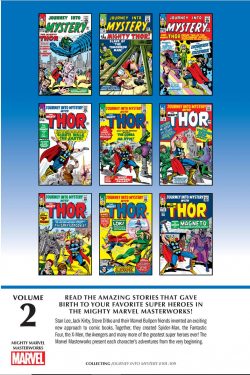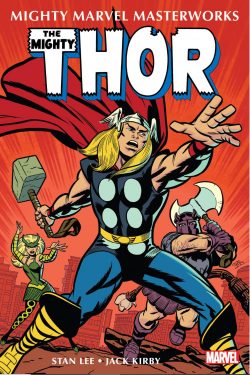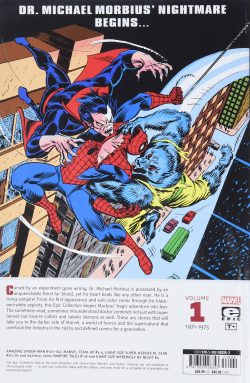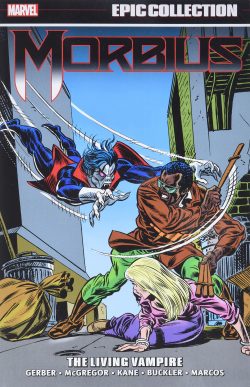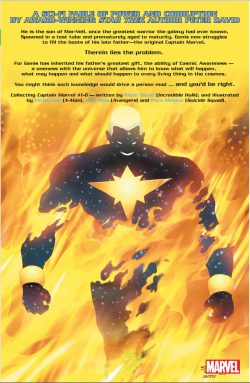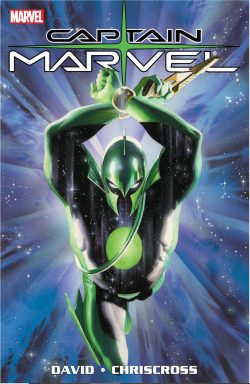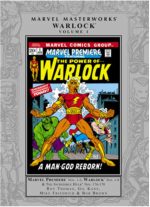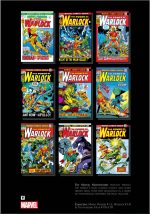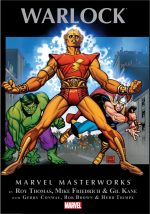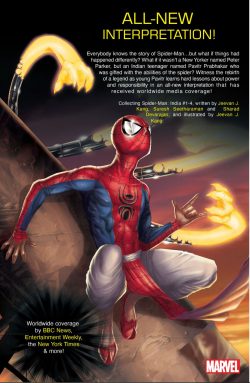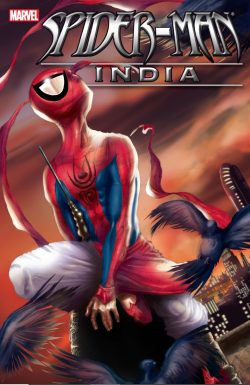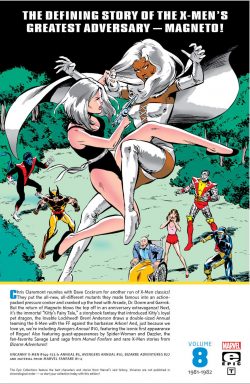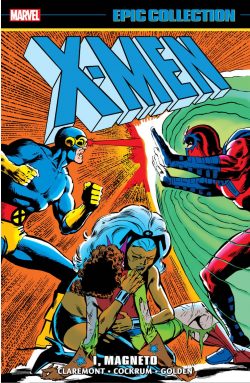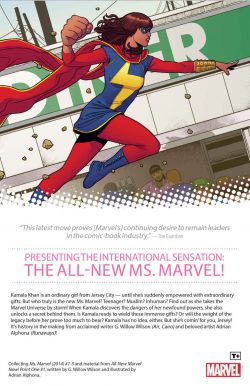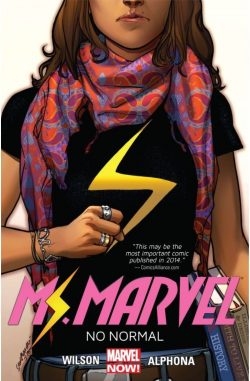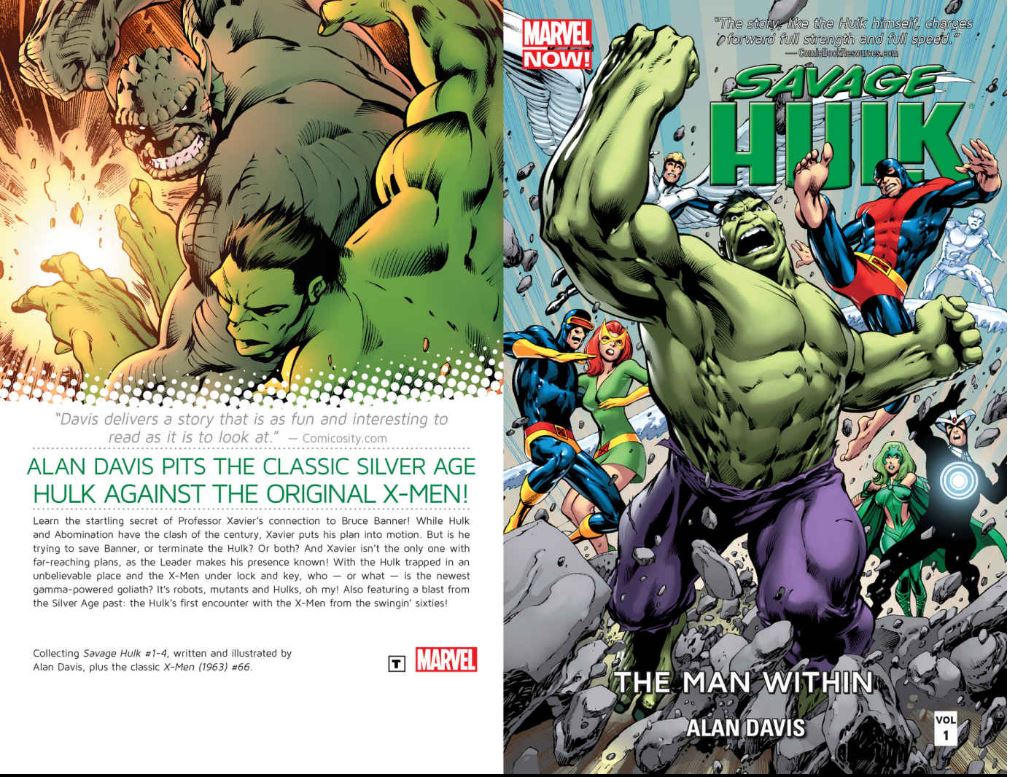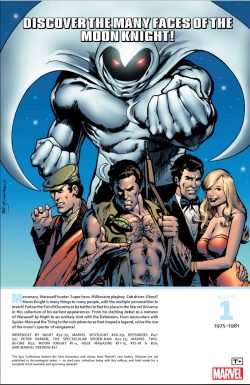
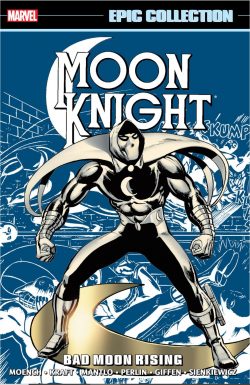
By Doug Moench, David Anthony Kraft, Bill Mantlo, Steven Grant, Roger Slifer, John Warner, Don Perlin, Bill Sienkiewicz, Keith Giffen, Mike Zeck, Jim Mooney, Jim Craig, Gene Colan, Keith Pollard & various (Marvel)
ISBN: 978-0-7851-2092-6 (TPB/Digital edition)
Moon Knight is probably the most complex and convoluted hero(es) in comics. There’s also a lot of eminently readable strip evidence to support the contention that he’s a certifiable loon.
The mercurial champion first appeared during the 1970s horror boom: a mercenary Batman knockoff hired by corporate villains to capture a monster. Sparking reader attention, the mercenary spun off into a brace of solo trial issues in Marvel Spotlight and welter of guest shots before securing an exceedingly sophisticated back-up slot in the TV inspired Hulk Magazine before graduating to the first of many solo series.
His convoluted origin eventually revealed how multiple-personality-suffering CIA spook-turned-mercenary Marc Spector was murdered by his boss and apparently resurrected by an Egyptian god…
This first epic compilation re-presents Werewolf by Night #32-33; Marvel Spotlight #28-29; Defenders #47-50, Peter Parker, The Spectacular Spider-Man #22-23; Marvel Two-In-One #52; material from Hulk Magazine #11-15, 17-18 & 20; Marvel Preview #21 and Moon Knight #1-4, spanning 1975 to 1981.
It all began in Werewolf by Night #32 (August 1975) and another stage in a long-running plot thread. Accursed lycanthrope Jack Russell and his sister Lyssa had been targets of criminal capitalists the Corporation for months. The plutocratic cabal believed that by terrorising the public, they could induce them to spend more…
Here Doug Moench & Don Perlin (with assistance from little Howie Perlin) introduced mercenary Marc Spector: a rough and ready modern warrior hired by plutocratic plunderers and equipped with a silver-armoured costume and weapons to capture Russell or his animal other as ‘…The Stalker Called Moon Knight’.
The bombastic battle and its ferocious sequel ‘Wolf-Beast vs. Moon Knight’ received an unprecedented response and rapidly propelled the lunar avenger to prominence as Marvel’s edgy answer to Batman: especially after the mercurial merc rejected his latest loathsome employers’ entreaties and let the wolf, as well as collateral hostages Lissa and Topaz, run free…
Within a year the spectral sentinel had returned for a two-part solo mission that fleshed out his characters (yes, plural!) and hinted at a hidden history behind the simple mercenary façade. Cover-dated June & August 1976, Marvel Spotlight #28-29 ‘The Crushing Conquer-Lord!’ and concluding chapter ‘The Deadly Gambit of Conquer-Lord!’ reveal the mercenary to be a well-established clandestine crimebuster with vast financial resources, a dedicated team of assistants including pilot “Frenchy” and secretary Marlene as well as wide-ranging network of street informants, a mansion/secret HQ, a ton of cool gadgets and at least four separate identities.
This latter aspect would inform Moon Knight’s entire career as various creators explored where playacting ended and Multiple Personality Disorder – if not outright supernatural possession – began…
Thanks to his brush with the werewolf, the masked vigilante had also gained a partial superpower. As the moon waxed and waned, his physical strength speed, stamina and resilience also doubled and diminished.
Here, billionaire Steven Grant, New York cabbie/information gatherer Jake Lockley, repentant gun-for-hire Marc Spector and the mysterious Moon Knight discovered he had been targeted by ruthless mastermind Mr. Quinn, who sought to eliminate a potential impediment in his plane to become a supervillain and rule Manhattan. The cunning criminal had placed a spy in Steven Grant’s inner circle and subsequent research revealed how Spector – a former CIA unarmed combat and weapons expert – had infiltrated the Corporation, gained powers, created alternate identities and, for unknown reasons, declared war on crime…
Sadly, despite this devious scheme and deploying plenty of his own wonder weapons and henchmen, the Conquer-Lord proves no match for the hidden hero in a gripping thriller by Moench & Perlin.
Following a quartet of previous collection covers by Gil Kane & Tom Smith, Perlin & Matt Milla, Bill Sienkiewicz & John Kalisz, and Sienkiewicz, Klaus Janson & Thomas Mason, the spectral sentinel’s next appearance was as a guest in a long running super-team saga.
Beginning with ‘Night Moves!’ in Defenders #47 (May 1977 and running through #50 and beyond), John Warner, David Anthony Kraft, Roger Slifer, Keith Giffen – in full Kirby mimic mode – with inkers Janson & Mike Royer disclose how putative loner Moon Knight is drawn into a war between a supervillain suffering a despondent mid-life crisis and the heroic “non-team” of Nighthawk, Valkyrie, Hellcat and The Hulk.
It begins in New Jersey, as the late-patrolling vigilante stumbles upon an abduction. When S.H.I.E.L.D. boss Nick Fury “arrests” Valkyrie’s former husband Jack Norriss in a most unorthodox manner, Moon Knight rescues Jack, taking him to Doctor Strange. Before long, MK’s somehow fighting Avenger Wonder Man, and thereafter catapulted into an aging Bad Guy’s existential crisis in #48’s ‘Who Remembers Scorpio? Part 1: Sinister Savior’…
Certainly not Jack, now a captive audience to Fury’s supposedly dead brother, who bemoans his lot in life while waiting for his new Zodiac team to mature and leave the Life Model Decoy machine currently constructing them…
When the Knight finds them, he’s caught in a deadly death trap, as Nighthawk is captured and added to the whining villain’s unwilling audience. Moon Knight’s escape and dash for reinforcements coincides with Hulk’s latest ‘Rampage’ through Manhattan in #49, allowing MK to lead him back to the Zodiac base, with Hellcat and Valkyrie close behind them.
Everyone meets up just as the artificial Zodiac is prematurely born, with double-length Defenders #50 hosting massive, manic free-for-all ‘Who Remembers Scorpio? Part 3: Scorpio Must Die!’
The clash ends in tragedy and Moon Knight’s departure, but not before an extract from #51’s ‘A Round with the Ringer!’ reveals the shocking secret of Fury’s involvement and exactly how the Knight in White escaped that aforementioned death trap…
You’re not really a Marvel Superhero until you meet the wondrous webslinger, and that initial introduction came in Peter Parker, The Spectacular Spider-Man #22-23 (September & October 1978) as Bill Mantlo, Mike Zeck & Bruce D. Patterson detail an underworld plot to destroy the mysterious vigilante ‘By the Light of the Silvery Moon Knight!’
When an informant is gunned down warning the Maggia have ferreted out one of his secret identities, Moon Knight learns the lethal legacy of Conquer-Lord’s files have made targets of his other assets, including diner owner Gena and homeless derelict Crawley. Lockley seeks to save them from assassination as Spider-Man is just passing, and the webslinger intervenes to save lives and keep his neighbourhood friendly…
After the traditional misunderstanding Meet-&-Beat-Up, Spidey and Moon Knight unite just in time to battle the Maggia’s top super-enforcer… French speedster Cyclone!
The saga concludes courtesy of artists Jim Mooney & Mike Esposito as the wallcrawler enviously scopes out MK HQ before joining a punitive counterstrike on the crime combine in ‘Guess Who’s Buried in Grant’s Tomb!’
Cover-dated June 1979, one last guest shot preceded MK’s transition to a solo series. In Marvel Two-In-One #52, Steven Grant – the real one Spector’s alter ego is teasingly based on – and artist Jim Craig & Pablo Marcos had the mysterious Moon Knight ally with The Thing to stop CIA Psy-Ops master Crossfire from brainwashing the city’s superheroes into killing each other…
Superhero credentials suitably established, Moon Knight began carving out his uniquely twisted corner of the Marvel Universe in a psychologically-themed vehicle aimed at an older, more general audience.
Originally released as newsprint monochrome magazine The Rampaging Hulk, the advent of the company’s “Marvelcolor” process and a hugely successful TV show starring the Green Goliath saw the periodical upgraded to slicker paper stock and obliquely continuity-adjacent storylines to address the needs of casual readers/television converts.
Supposedly a more sophisticated product, the book offered a home to Moon Knight, who moved in for a series of dark modern tales also outside standard superhero parameters. Before those begin here, Hulk Magazine #11 (October 1978) provides Bob Larkin’s wraparound painted cover, a house ad from #10 and a text introduction extolling the virtues of artistic debutante Bill Sienkiewicz from #13…
A new era dawned with ‘Graven Image of Death’ (#11, by Moench, Gene Colan & Tony DeZuñiga) as the hooded hunter stumbles into a murderous war between rival antiquities collectors Joel Luxor and Anton Varro: millionaires vying for possession of a statuette of Egyptian god Horus. As bodies stack up, Moon Knight despatches Grant’s assistant/paramour Marlene to question museum curator Fenton Crane and is barely in time to stop her joining the body count in #12’s ‘Embassy of Fear!’ (Moench, Keith Pollard, Frank Giacoia & Esposito).
On learning the entire affair is simply smoke and mirrors for a larger scheme, with the statue simply moneymaking collateral in an international terrorism plot, Moon Knight buys in as shady millionaire Grant to work undercover. He is unaware that another mastermind has obtained Conquer-Lord’s files and it’s all a trap.
Hulk Magazine #13 (February 1979) was Sienkiewicz’s moment. On ‘The Big Blackmail’ his sleek imitation of classic Neal Adams hyperrealism (and Batman swipe files) combined with Steve Oliff’s advanced colour techniques, were breathtaking as enigmatic Machiavelli Lupinar observed the hero’s friends and allies at dangerously close quarters. Orchestrating nuclear armageddon with Moon Knight as his unwitting dupe, legendary operative Marc Spector was his true target…
After wading through layers of murderous multinational intermediaries, Moon Knight finally confronts his bestial hidden enemy in #14’s ‘Countdown to Dark’ (Bob McLeod inks) in a furious fight to the death as a nuclear clock inexorably counts down…
A smart crossover follows after a gallery of Hulk covers – #12-15 by Joe Jusko, Earl Norem, Larkin & Peter Ledger before June 1980’s #15 hosted a single encounter told from two perspectives. Moench, Sienkiewicz & McLeod explored ‘An Eclipse, Waning’ with Grant indulging a neglected passion for astronomy by visiting an old pal in the countryside on the night of a total lunar occultation.
The event brings brutal burglars out of the woodwork and Moon Knight is required to stop them, but, bizarrely, at the height of the eclipse, during the moment of utter darkness, the Lunar Avenger encounters something huge, monstrous and unbeatable, barely escaping with his life.
Answers come in ‘An Eclipse Waxing’ as on that same night , fugitive Bruce Banner meets burglars breaking into an isolated house and helplessly transforms into the Hulk again. Just as total night falls, the monster briefly encounters an unseen foe of far greater capabilities…
Norem, Larkin and Jusko covers for #17, 18 and 20 precede some longed-awaited revelations of the White Knight’s troubled past, emerging when as regular Moon Knight feature resumed in #17. In a chilling, disturbing sequence inked by Klaus Janson, ‘Nights Born Ten Years Gone Part I-III’ finds Manhattan terrorised by a mad axeman stalking nightshift nurses.
Wearing pyjama bottoms and a clown mask, the “Hatchet-Man” has racked up nine kills before Moon Night’s street agents present evidence indicating a close historical connection to Spector. Always cautious, the Man of Many Parts is parsimonious in sharing knowledge and Marlene convinces him that she can safely act as bait…
The ploy goes appallingly wrong and she is severely injured by both the police and the axe-man, leading to the incensed lunar vigilante going wild amidst the ‘Shadows in the Heart of the City’ as the frustrated maniac spirals out of control
However, although the killer is stopped, the guilt-wracked hero tirelessly works a night of minor life-saving exploits and endures anxious terrors before Marlene is safe in ‘A Long Way to Dawn’…
That euphoric fable appeared in Hulk Magazine #20 (April 1980) and was Moon Knight’s swan song there, but he resurfaced in a complex conspiracy mystery in monochrome magazine Marvel Preview (#21, Spring 1980).
Behind the Sienkiewicz, Larkin, Janson & Oliff cover here and preceded by the penciller’s B&W frontispiece ‘The Mind Thieves’ and concluding chapter ‘Vipers’ come from a later colourised reprint, but retain all the sinister paranoic confusion of the Moench, Sienkiewicz, Tom Palmer & Dan Greene original.
When a corpse is delivered to Grant’s mansion, it reactivates Spector’s CIA career and sets Moon Knight on the trail of unfinished business in a “Company” mind control lab supposedly decommissioned years previously…
Following a trail of dead men, dirty secrets, and programable super-killers, MK, Marlene and Frenchy escape barely death in Montreal and Paris while exposing a vicious vengeance plot behind the dirty tricks campaign. It almost costs them everything…
Appended by Ralph Macchio’s editorial ‘Full Phase’, the story closes one chapter in the character’s life and leads into the far mor complex and conflicted career of a man seeking atonement as the November cover-dated premier solo title exposes the secrets of ‘The Macabre Moon Knight!’
Here Moench, Sienkiewicz & Frank Springer reveal how world-weary, burned-out mercenary Spector was working for murderous marauder Raul Bushman but reclaimed his moral compass after his ruthless boss murdered archaeologist Peter Alraune for the contents of a recently excavated Sudanese tomb. The scientist’s daughter Marlene escaped, as did equally disgusted comrade Frenchy, but when Spector attempted to stop Bushman executing witnesses he was beaten and left to die in the desert.
Dying by degrees, Spector crawled for miles and died just as he enters the tomb of Pharoah Seti, where Marlene and her workers were hiding. Dumped at the feet of a statue of Khonshu – god of the Moon and Taker of Vengeance – he inexplicably revived. Clearly deranged, he draped the statue’s white mantle around himself, before going out into the night. By dawn, Bushman’s band are dead and the monster fled…
Skipping forward to now and hinting at a long eventful road to the life of a multi-identity superhero, the origin ends with a fateful showdown with the returned Bushman in his New York lair…
Barely pausing, #2 focuses on pitiful peeping pawn Crawley in a powerful human interest tale. The city reels under the bloody shadow of a butcher hunting bums and indigents. With corpses no one cares about mounting, Moon Knight soon learns ‘The Slasher’ is seeking one specific homeless man, and will not stop until he finds him…
Cover-dated January 1981, #3 sees Sienkiewicz ink himself as ‘Midnight Means Murder’ with the Knight of the Moon facing ruthless thief Anton Mogart/The Midnight Man, before the saga pauses with #4 and the Janson-inked action thriller ‘A Committee of 5’. Here, the Lunar Avenger is hunted by and hunts in return a quintet of specialist assassins. Happily, fortune augments ability and Khonshu’s chosen is more than a match for the killer elite…
Accompanied throughout by covers from Gil Kane, Al Milgrom, Klaus Janson, Perlin, Jack Kirby, Ed Hannigan, Joe Sinnott, Dave Cockrum, Joe Rubinstein, Keith Pollard, George Pérez, Sienkiewicz and others, the extras are supplemented by Sienkiewicz’s wrapround covers from Moon Knight Special Edition #1-3 and the 6-plate character portfolio contained therein, plus Jim Shooter’s introduction.
Also on show are contemporary house ads; printed trivia; previous collection covers; the painted cover to fanzine Amazing Heroes #6 and 11 pages of original art and covers by Milgrom, Cockrum, Rubinstein, Sienkiewicz, McLeod, Springer & Janson.
Moody, dark, thematically off-kilter and savagely entertaining this first volume sees a Batman knock-off evolve into a unique example of the line between hero and villain and sinner and saint all wrapped up in pure electric entertainment for testosterone junkies and
© 2019 MARVEL.
